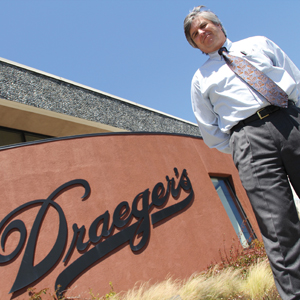After 14 years, Zanotto’s downtown San Jose market is finally closing its doors. By the end of the month, the local family chain plans to shutter the city-subsidized location, which has struggled since it opened in 1996.
Zanotto’s isn’t completely abandoning the downtown area. Troy Tibbles, the store’s manager, says they’ll soon ink a lease on a nearby spot formerly occupied by a pizza parlor and reopen there as a smaller deli operation on Aug. 1. Zanotto’s Express, as the new venture will be called, will serve up sandwiches, salads and sushi in a grab-and-go format.
“What we’re going to try and do is service the lunch clientele,” said Tibbles, who has been with the Zanotto’s family since 1984 and took over management of the downtown location in 2002.
Like Zanotto’s, other South Bay independent grocers have struggled to stay open as the economy tanked or bigger competitors, from specialty grocers to big box stores, moved in on what was once their turf. In February, valley institution Cosentino’s closed down after 63 years in the grocery business. Last year, PW Markets transitioned from grocer to real estate agency when they began leasing the buildings that once held their five San Jose stores.
Tibbles says his store has had to battle with inconvenient parking access, poor visibility in its mid-block location and a lack of downtown development. The 88, a stylish nearby condo tower, was supposed to bring in more shoppers, but it brought instead a jarring surprise: competition in the form of a Safeway’s “the Market” in a ground-floor retail space. “And we didn’t see that coming,” said Tibbles. “That was the straw that broke the camel’s back, if you will.”
With news of the Safeway store opening, Zanotto’s temporarily closed down to shrink its leased space from 22,000 square feet to 14,000 square feet, about the size of the Naglee Avenue location. The smaller space just wasn’t enough.
Lunch Counter
Other independent markets in the South Bay have had to adjust their game plan when a new, national chain set up shop.
Steve Pinney, general manager at Lunardi’s Los Gatos store, was working as a night clerk several years ago when Whole Foods Market announced a new store just on the other side of Blossom Hill Road.
“When we heard that they were going in, that’s what pushed us into getting organic foods and natural foods,” said Pinney, who’s been with Lunardi’s since 1987. “As a result we kind of built up a clientele for that before they even opened,” he said.
{pagebreak}
Lunardi’s has eight shops around the Bay Area. Pinney says business at his store is doing well. In fact, the chain just opened a new store in the spot formerly occupied by Cosentino’s on South Bascom Avenue in San Jose.
But it’s not just Whole Foods and Safeway vying for his customers. “We’re getting competition now from Target and Wal-Mart,” says Pinney, referring to the megaretailers that now sell fresh produce and packaged foods.
Draeger’s Markets, with stores in San Mateo, Menlo Park, Los Altos and Danville, has survived by offering the distinct local products that the bigger chains don’t carry.
“We’re a small, local retailer,” says Richard Draeger. “When it comes to sourcing local products, of course, who can do that better than a small, local retailer?”
Draeger says his stores are doing better as his customers feel a little more confident about the economy.
“We’re starting to see a little growth again,” says Draeger. “It’s been a little while since I could say that.”
Like the other grocers interviewed for this story, Draeger says he is on friendly terms with his fellow independent grocery chains. He said was saddened to hear about the downtown Zanotto’s closure, but that he wasn’t completely surprised.
“They haven’t really done well with that location since day one,” he says.
Tibbles says that about two years ago, when they saw that business just wasn’t working out, they began exploring new options. With all of downtown’s vacancies, Tibbles says, it wasn’t hard to find new space.
The store won’t lay off any employees. They’ve been operating with a deli-size staff for several months. Nine of them have been with the store since it opened in 1996.
He’s cautiously optimistic about the leaner venture, noting that the store’s strong lunch-customer following puts them in a better position than a new sandwich shop.
“We have 14 years of building a brand to that lunch customer, which is hard to do if you just open up a small-format deli and you’re not known,” he says.
Tibbles says he’s torn about closing the larger store.
“The worst part is the disappointment from loyal customers who have supported the store since its opening,” he says. “The other side of it is that it’s been a lot more work than it’s ever been reward, and I’m grateful that it’s going to be behind us.”

 The Tubes at Montalvo
The Tubes at Montalvo 









